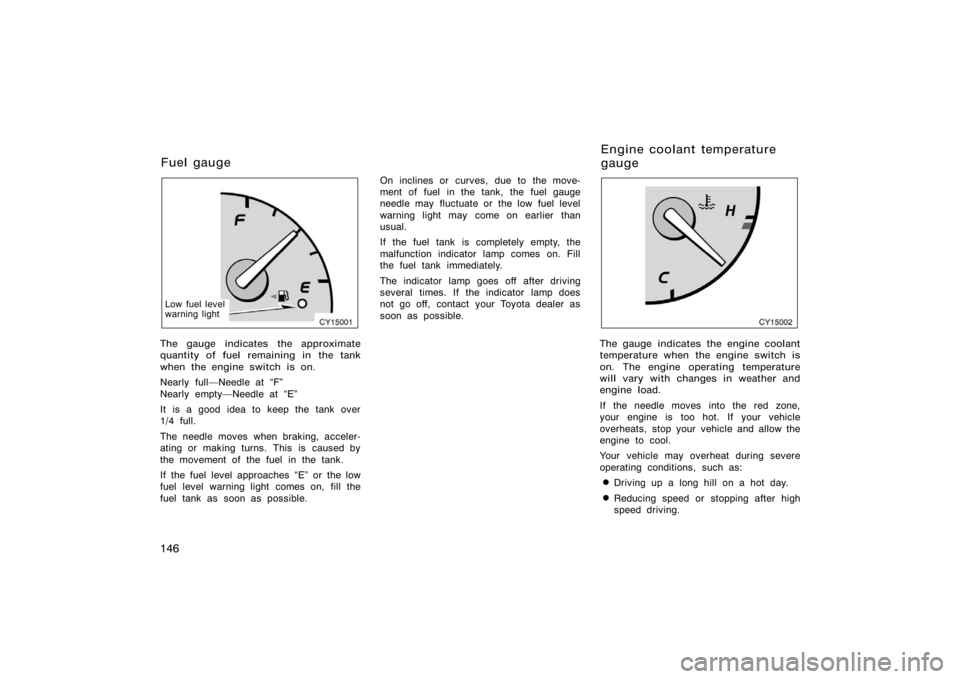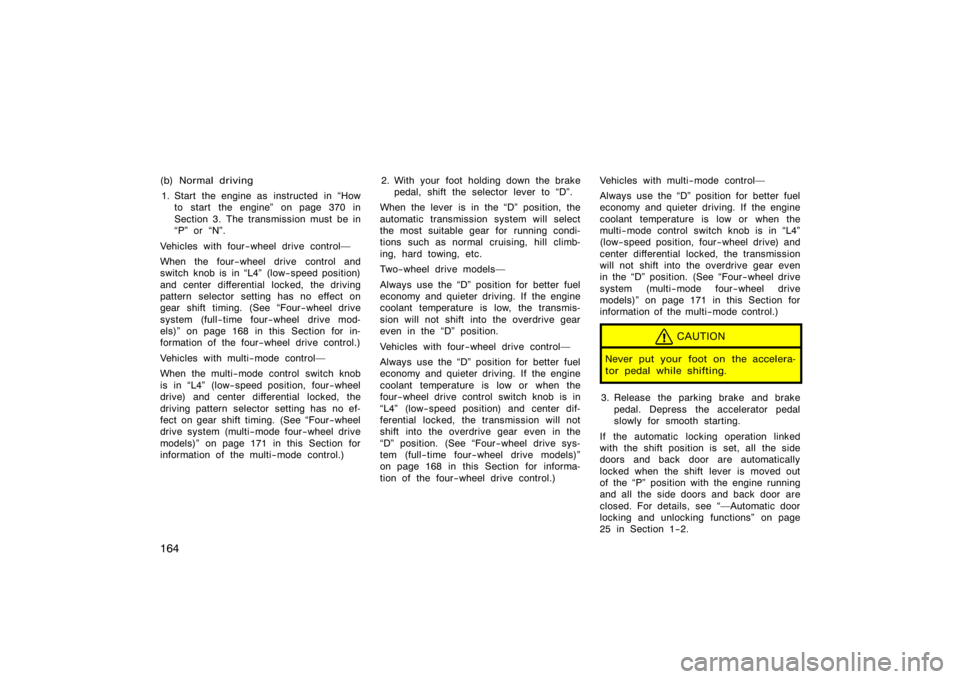Page 18 of 496
6
CY11062
1. Tachometer
2. Speedometer
3. Service reminder indicators andindicator lights 4. Fuel gauge
5. Low fuel level warning light
6. Engine coolant temperature gauge
7. Trip meter reset knob
8. Odometer and two trip meters
Instrument cluster overview
�
Ty p e A
Page 19 of 496
7
CY11067
1. Service reminder indicators andindicator lights
2. Tachometer 3. Speedometer
4. Fuel gauge
5. Low fuel level warning light6. Engine coolant temperature gauge
7. Trip meter reset knob
8. Odometer and two trip meters
�
Ty p e B
Page 157 of 496
145
OPERATION OF INSTRUMENTS AND
CONTROLS
Gauges, Meters and Service reminder indicators
Fuel gauge146
. . . . . . . . . . . . . . . . . . . . . . . . . . . . . . . . . . . . .\
. . . . . . . . . . .
Engine coolant temperature gauge 146
. . . . . . . . . . . . . . . . . . . . . . . . . . .
Tachometer 147
. . . . . . . . . . . . . . . . . . . . . . . . . . . . . . . . . . . . \
. . . . . . . . . . . .
Odometer and two trip meters 148
. . . . . . . . . . . . . . . . . . . . . . . . . . . . . . . .
Service reminder indicators and warning buzzers 149
. . . . . . . . . . . . . .
SECTION 1− 6
Page 158 of 496

146
CY15001
Low fuel level
warning light
The gauge indicates the approximate
quantity of fuel remaining in the tank
when the engine switch is on.
Nearly full�Needle at �F"
Nearly empty�Needle at �E"
It is a good idea to keep the tank over
1/4 full.
The needle moves when braking, acceler-
ating or making turns. This is caused by
the movement of the fuel in the tank.
If the fuel level approaches �E" or the low
fuel level warning light comes on, fill the
fuel tank as soon as possible.On inclines or curves, due to the move-
ment of fuel in the tank, the fuel gauge
needle may fluctuate or the low fuel level
warning light may come on earlier than
usual.
If the fuel tank is completely empty, the
malfunction indicator lamp comes on. Fill
the fuel tank immediately.
The indicator lamp goes off after driving
several times. If the indicator lamp does
not go off, contact your Toyota dealer as
soon as possible.
CY15002
The gauge indicates the engine coolant
temperature when the engine switch is
on. The engine operating temperature
will vary with changes in weather and
engine load.
If the needle moves into the red zone,
your engine is too hot. If your vehicle
overheats, stop your vehicle and allow the
engine to cool.
Your vehicle may overheat during severe
operating conditions, such as:
�Driving up a long hill on a hot day.
�Reducing speed or stopping after high
speed driving.
Fuel gauge
Engine coolant temperature
gauge
Page 159 of 496
147
�
Idling for a long period with the air
conditioning on in stop−and−go traffic.
�Towing a trailer.
NOTICE
�
Do not remove the thermostat in
the engine cooling system as this
may cause the engine to overheat.
The thermostat is designed to con-
trol the flow of coolant to keep the
temperature of the engine within
the specified operating range.
� Do not continue driving with an
overheated engine. See �If your
vehicle overheats" on page 394 in
Section 4.CY15003
The tachometer indicates engine speed
in thousands of rpm (revolutions per
minute). Use it while driving to select
correct shift points and to prevent en-
gine lugging and over−revving.
Driving with the engine running too fast
causes excessive engine wear and poor
fuel economy. Remember, in most cases
the slower the engine speed, the greater
the fuel economy.
NOTICE
Do not let the indicator needle get
into the red zone. This may cause
severe engine damage.
Tachometer
Page 176 of 496

164
(b) Normal driving1. Start the engine as instructed in �How to start the engine" on page 370 in
Section 3. The transmission must be in
�P" or �N".
Vehicles with four−wheel drive control�
When the four−wheel drive control and
switch knob is in �L4" (low−speed position)
and center differential locked, the driving
pattern selector setting has no effect on
gear shift timing. (See �Four−wheel drive
system (full−time four−w heel drive mod-
els)" on page 168 in this Section for in-
formation of the four−wheel drive control.)
Vehicles with multi−mode control�
When the multi−mode control switch knob
is in �L4" (low−speed position, four−wheel
drive) and center differential locked, the
driving pattern selector setting has no ef-
fect on gear shift timing. (See �Four−wheel
drive system (multi−mode four−wheel drive
models)" on page 171 in this Section for
information of the multi−mode control.) 2. With your foot holding down the brake
pedal, shift the selector lever to �D".
When the lever is in the �D" position, the
automatic transmission system will select
the most suitable gear for running condi-
tions such as normal cruising, hill climb-
ing, hard towing, etc.
Two−wheel drive models�
Always use the �D" position for better fuel
economy and quieter driving. If the engine
coolant temperature is low, the transmis-
sion will not shift into the overdrive gear
even in the �D" position.
Vehicles with four−wheel drive control�
Always use the �D" position for better fuel
economy and quieter driving. If the engine
coolant temperature is low or when the
four−wheel drive control switch knob is in
�L4" (low−speed position) and center dif-
ferential locked, the transmission will not
shift into the overdrive gear even in the
�D" position. (See �Four−wheel drive sys-
tem (full−time four−wheel drive models)"
on page 168 in this Section for informa-
tion of the four−wheel drive control.) Vehicles with multi−mode control�
Always use the �D" position for better fuel
economy and quieter driving. If the engine
coolant temperature is low or when the
multi−mode control switch knob is in �L4"
(low−speed position, four−wheel drive) and
center differential locked, the transmission
will not shift into the overdrive gear even
in the �D" position. (See �Four−wheel drive
system (multi−mode four−w
heel drive
models)" on page 171 in this Section for
information of the multi−mode control.)
CAUTION
Never put your foot on the accelera-
tor pedal while shifting.
3. Release the parking brake and brake
pedal. Depress the accelerator pedal
slowly for smooth starting.
If the automatic locking operation linked
with the shift position is set, all the side
doors and back door are automatically
locked when the shift lever is moved out
of the �P" position with the engine running
and all the side doors and back door are
closed. For details, see ��Automatic door
locking and unlocking functions" on page
25 in Section 1−2.
Page 369 of 496

357
Ti r e relat ed ter m
Meaning
Cold tire inflation pressure
tire inflation pressure when the vehicle has been parked for at least 3 hours
or more, or it has not been driven more than 1.5 km or 1 mile under that
condition
Maximum inflation pressurethe maximum cold inflation
pressure to which a tire may be inflated and it is
shown on the sidewall of the tire
Recommended inflation pressurecold tire inflation pressure recommended by a manufacturer
Accessory weight
the combined weight (in excess of those standard items which may be replaced)
of automatic transmission, power steering, power brakes, power windows, pow-
er seats, radio, and heater, to the extent that these items are available as
factory−installed equipment (whether installed or not)
Curb weight
the weight of a motor vehicle with standard equipment including the maximum
capacity of fuel, oil, and coolant, and, if so equipped, air conditioning and addi-
tional weight optional engine
Maximum loaded vehicle weight
the sum of�
(a) curb weight;
(b) accessory weight;
(c) vehicle capacity weight; and
(d) production options weight
Normal occupant weight68 kg (150 lb.) times the number of occupants specified in the second column
of Table 1 that follows
�Glossary of tire terminology
Page 387 of 496

375
NOTICE
�If driving through water, such as
when crossing shallow streams,
first check the depth of the water
and the bottom of the river bed for
firmness. Drive slowly and avoid
deep water.
� Take all necessary safety measures
to ensure that water damage to the
engine or other components does
not occur.
� Water entering the engine air intake
will cause severe engine damage.
� Water entering the automatic trans-
mission will cause deterioration in
shift quality, locking up of your
transmission accompanied by vibra-
tion, and ultimately damage.
� Water can wash the grease from
wheel bearings, causing rusting and
premature failure, and may also en-
ter the differentials, transmission
and transfer case, reducing the gear
oil’s lubricating qualities.
�Sand and mud that has accumulated
in brake drums and around brake
discs may affect braking efficiency
and may damage brake system com-
ponents.
� Always perform a maintenance
inspection after each day of
off−road driving that has taken you
through rough terrain, sand, mud,
or water. For scheduled
maintenance information, refer to
the �Scheduled Maintenance Guide"
or �Owner ’s Manual Supplement".Make sure your coolant is properly pro-
tected against freezing.
Only use �Toyota Super Long Life Coolant"
or similar high quality ethylene glycol
based non−silicate, non−amine, non−nitrite,
and non−borate coolant with long−life hy-
brid organic acid technology. (Coolant with
long−life hybrid organic acid technology is
a combination of low phosphates and or-
ganic acids.)
See �Checking the engine coolant level"
on page 438 in Section 7−2 for details of
coolant type selection.
For the U.S.A.��Toyota Super Long Life
Coolant" is a mixture of 50% coolant and
50% deionized water. This coolant pro-
vides protection down to about −35 �C
(−31 �F).
For the Canada��Toyota Super Long Life
Coolant" is a mixture of 55% coolant and
45% deionized water. This coolant pro-
vides protection down to about −42 �C
(−44 �F).
NOTICE
Do not use plain water alone.
Winter driving tips